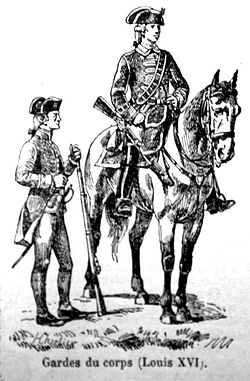
Two Guardsmen during the reign of Louis XVI. Coats were dark blue with red facings and silver lace. Waistcoats and breeches were red.

Garde du corps 4th company in 1786
The Garde du Corps (French pronunciation: [ɡaʁd dy kɔʁ], Bodyguard) was the senior formation of the King of France's Household Cavalry within the Maison du Roi.
History
The oldest company in the Garde du Corps was the Company of Scottish Archers, later just the 1st Scottish Company or Garde Écossaise, formed in 1419 from Scots that fought for the French during Hundred Years' War.
In the Battle of Fornovo during the Italian Wars the Garde du Corps saved king Charles VIII from being captured by enemy forces. Later in the Italian Wars they failed to save Francis I from being captured in the Battle of Pavia.
The last time the Garde du Corps campaigned was during the War of the Austrian Succession because it only went on campaign when the king was present. The last battle in which the Garde du Corps was present was Lauffeld on 1 July 1747.
Revolution and Restoration
The Garde du Corps featured conspicuously in several incidents in the opening stages of the French Revolution. On 1 October 1789 the officers of the Garde hosted a banquet to welcome their colleagues of a line infantry regiment of the Royal Army which had been brought to Versailles to replace the disbanded French Guards (Gardes Francais). The latter regiment had joined in the attack on the Bastille six weeks before. The banquet was reported in Paris as a royalist provocation and an angry crowd of thousands marched on Versailles. During the night of 5 October about 500 members of the crowd broke into the Palace, killing several of the Gardes du Corps on duty. Other Gardes du Corps held the doors to the royal apartments until grenadiers of the National Guard – mostly former Gardes Francais – restored order. The Garde du Corps narrowly escaped massacre and, disarmed, was obliged to accompany the Royal Family to Paris. Most of this aristocratic regiment then dispersed to their estates or into exile.
The Garde du Corps was formally dissolved in 1791 along with all of the Maison du Roi, except for the ill fated Swiss Guard. After the abdication of Napoleon I in April 1814 and the Bourbon Restoration, Louis XVIII recreated the Garde du Corps with the rest of the Maison du Roi. These units disappeared during Napoleon's return, at the start of the Hundred Days.
After Waterloo and the return of the Bourbons the Garde du Corps was recreated again, almost the only unit of the old Maison du Roi to be given a further chance after the disappointing performance of these expensive and militarily obsolete regiments in 1815. The Garde du Corps was however reorganised, reduced in numbers to about 1,500 and integrated more closely with the regular army. The reconstituted Garde du Corps served the returned Bourbons loyally until being finally abolished, along with all Guard units, by Louis-Philippe in 1830 after the July Revolution.
Motto
The original motto of the Garde du Corps was Erit haec quoque cognita monstris (They will be recognized, them also, with their brilliant deeds), but during the reign of Louis XIV it changed to Nec pluribus impar (No unequal match for many (suns)), which also was Louis XIV's personal motto.
The swords of the guardsmen was inscribed with Vive le Roi (Long live the king).
Composition
- 1st Scottish Company – formed in 1440 by Charles VII. Despite the name, by the 16th century the company has ceased to be purely Scottish. Little by little the Scottish Company became only Scottish in name.
- 1st French Company – formed in 1475 by Louis XI.
- 2nd French Company – formed in 1479 by Louis XI.
- 3rd French Company – formed in 1516 by Francis I.
Gardes de la Manche
The Gardes de la Manche (English: Guards of the Sleeve) was an elite detachment formed as the king's personal guard by Charles VII with men from the Company of Scottish Archers. They were the 24 oldest men of the 1st Scottish Company. The name came from the fact that they stood so close to the king as to be brushed by his sleeves. In 1775 this guard was reduced to 18 men. The captain of the Garde de La Marche was called the First Man-at-arms of France.
A later, less successful, bodyguard was The Forty-Five, recruited by the Duke of Épernon to provide Henry III of France with protection in the midst of the War of the Three Henrys. They served Henry III and Henry IV of France, but were unable to prevent both monarchs being assassinated.
References
- Chartrand, René. Louis XIV's Army. London: Osprey Publishing, 1988. ISBN 0-85045-850-1
- Chartrand, René. Louis XV's Army (1) Cavalry & Dragoons. London: Osprey Publishing, 1996. ISBN 1-85532-602-7
- Philip Mansel. Pillars of Monarchy. London: Quartet Books 1984. ISBN 0-7043-2424-5
| Wikimedia Commons has media related to French uniforms of the royal guard. |
The original article can be found at Garde du Corps (France) and the edit history here.